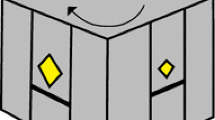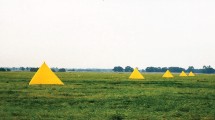Abstract
Categorization refers to the classification of perceptual input into defined functional groups. We present and discuss evidence suggesting that stimulus categorization can also be found in an invertebrate, the honeybee Apis mellifera, thus underlining the generality across species of this cognitive process. Honeybees show positive transfer of appropriate responding from a trained to a novel set of visual stimuli. Such a transfer was demonstrated for specific isolated features such as symmetry or orientation, but also for assemblies (layouts) of features. Although transfer from training to novel stimuli can be achieved by stimulus generalization of the training stimuli, most of these transfer tests involved clearly distinguishable stimuli for which generalization would be reduced. Though in most cases specific experimental controls such as stimulus balance and discriminability are still required, it seems appropriate to characterize the performance of honeybees as reflecting categorization. Further experiments should address the issue of which categorization theory accounts better for the visual performances of honeybees.





Similar content being viewed by others
References
Benard J, Giurfa M (2004) A test of transitive inferences in free-flying honeybees: unsuccessful performance due to memory constraints. Learn Mem 11:328–336
Bitterman ME (1996) Comparative analysis of learning in honeybees. Anim Learn Behav 24:123–141
Campan R, Lehrer M (2002) Discrimination of closed shapes by two species of bee, Apis mellifera and Megachile rotundata. J Exp Biol 205:559–572
Cartwright BA, Collett TS (1983) Landmark learning in bees. Experiments and models. J Comp Physiol A 151:521–543
Chen L (1982) Topological structure in visual perception. Science 218:699–700
Chen L, Zhang S, Srinivasan MV (2003) Global perception in small brains: topological pattern recognition in honeybees. Proc Natl Acad Sci USA 100:6884–6889
Chittka L, Thomson J, Waser NM (1999) Flower constancy, insect psychology, and plant evolution. Naturwissenschaften 86:361–377
Delius JD, Jitsumori M, Siemann M (2000) Stimulus equivalences through discrimination reversals. In: Heyes C, Huber L (eds) The evolution of cognition. MIT Press, Cambridge, MA, pp 103–122
Dill M, Wolf R, Heisenberg M (1993) Visual pattern recognition in Drosophila involves retinotopic matching. Nature 365:751–753
Efler D, Ronacher B (2000) Evidence against retinotopic-template matching in honeybees’ pattern recognition. Vis Res 40:3391–3403
Ernst R, Heisenberg M (1999) The memory template in Drosophila pattern vision at the flight simulator. Vis Res 39:3920–3933
Estes WK (1994) Classification and cognition. Oxford University Press, Oxford
Frisch Kv (1915) Der Farbensinn und Formensinn der Bienen. Zool Jb Abt Allg Zool Physiol 35:1–182
Frisch Kv (1962) Dialects in the language of bees. Sci Am 207:78–87
Frisch Kv (1967) The dance language and orientation of bees. Belknap Press, Cambridge, MA
Ghirlanda S, Enquist M (2003) A century of generalization. Anim Behav 66:15–36
Giurfa M, Núñez JA (1992) Honeybees mark with scent and reject recently visited flowers. Oecologia 89:113–117
Giurfa M (1993) The repellent scent-mark of the honeybee Apis mellifera ligustica and its role as communication cue during foraging. Insect Soc 40:59–67
Giurfa M, Eichmann B, Menzel R (1996) Symmetry perception in an insect. Nature 382:458–461
Giurfa M, Menzel R (1997) Insect visual perception: complex ability of a simple nervous system. Curr Opin Neurobiol 7:505–513
Giurfa M, Hammer M, Stach S, Stollhoff N, Müller-Deisig N, Mizyrycki C (1999) Pattern learning by honeybees: conditioning procedures and recognition strategy. Anim Behav 57:315–324
Giurfa M, Lehrer M (2001) Honeybee vision and floral displays: from detection to close-up recognition. In: Chittka L, Thomson JD (eds) Cognitive ecology of pollination. Cambridge University Press, Cambridge, pp 61–82
Giurfa M, Zhang S, Jenett A, Menzel R, Srinivasan MV (2001) The concepts of ‘sameness’ and ‘difference’ in an insect. Nature 410:930–933
Giurfa M (2003) Cognitive neuroethology: dissecting non-elemental learning in a honeybee brain. Curr Opin Neurobiol 13:726–735
Giurfa M, Schubert M, Reisenman C, Gerber B, Lachnit H (2003) The effect of cumulative experience on the use of elemental and configural visual discrimination strategies in honeybees. Behav Brain Res 145(1–2):161–169.
Gould JL (1985) How bees remember flower shapes. Science 227:1492–1494
Grossmann K (1970) Erlernen von Farbreizen an der Futterquelle durch Honigbienen während des Anfluges und während des Saugens. Z Tierpsychol 27:553–562
Guerrieri F, Schubert M, Sandoz JC, Giurfa M (2005) Perceptual and neural olfactory similarity in the honeybee. PLoS Biol 3(4):e60
Hammer M (1993) An identified neuron mediates the unconditioned stimulus in associative olfactory learning in honeybees. Nature 366:59–63
Harlow HF (1949) The formation of learning sets. Psychol Rev 56:51–65
Harnard S (1987) Categorical perception. The groundwork of cognition. Cambridge University Press, Cambridge
Hateren JH, Srinivasan MV, Wait PB (1990) Pattern recognition in bees: orientation discrimination. J Comp Physiol A 197:649–654
Hempel de Ibarra N, Giurfa M (2003) Discrimination of closed coloured shapes requires only contrast to the long wavelength receptor. Anim Behav 66:903–910
Herrnstein RJ (1990) Levels of stimulus control: a functional approach. Cognition 37:133–166
Hertz M (1933) Über figurale Intensität und Qualität in der optische Wahrnehmung der Biene. Biol Zentralbl 53:10–40
Hertz M (1935) Die Untersuchungen über den Formensinn der Honigbiene. Naturwissenschaften 23:618–624
Horridge GA, Zhang SW (1995) Pattern vision in honeybees (Apis mellifera): flower-like patterns with no predominant orientation. J Insect Physiol 41:681–688
Horridge GA (1996) Vision of the honeybee Apis mellifera for patterns with two pairs of equal orthogonal bars. J Insect Physiol 42:131–138
Horridge GA (1997a) Pattern discrimination by the honeybee: disruption as a cue. J Comp Physiol A 181:267–277
Horridge GA (1997b) Vision of the honeybee Apis mellifera for patterns with one pair of equal orthogonal bars. J Insect Physiol 43:741–748
Hubel DH, Wiesel TN (1962) Receptive fields, binocular interaction and functional architecture in the cat's visual cortex. J Physiol 160:106–154
Huber L (2001) Visual categorization in pigeons. In: Cook RG (ed) Avian visual cognition [on-line]. Available: www.pigeon.psy.tufts.edu/avc/huber/
Keller FS, Schoenfeld WN (1950) Principles of psychology. Appleton-Century-Crofts, New York
Maurer D, Le Grand R, Mondloch CJ (2002) The many faces of configural processing. TICS 6:255–260
Menzel R, Backhaus W (1991) Color vision in insects. In: Gouras P (ed) Vision and visual dysfunction. The perception of color. MacMillan Press, London, pp 262–288
Menzel R (1999) Memory dynamics in the honeybee. J Comp Physiol A 185:323–340
Menzel R (2001) Searching for the memory trace in a mini-brain, the honeybee. Learn Mem 8:53–62
Menzel R, Giurfa M (2001) Cognitive architecture of a minibrain: the honeybee. TICS 5:62–71
Møller AP, Eriksson M (1994) Patterns of fluctuating asymmetry in flowers: implications for sexual selection in plants. J Evol Biol 7:97–113
Møller AP, Eriksson M (1995) Pollinator preference for symmetrical flowers and sexual selection in plants. Oikos 73:15–22
Pastore RE (1987) Categorical perception: some psychophysical models. In: Harnard S (ed) Categorical perception. The groundwork of cognition. Cambridge University Press, Cambridge, pp 29–52
Robertson SI (2001) Problem solving. Psychology Press, East Sussex
Rodriguez I, Gumbert A, Hempel de Ibarra N, Kunze J, Giurfa M (2004) Symmetry is in the eye of the beeholder: innate preference for bilateral symmetry in flower-naive bumblebees. Naturwissenschaften 91:374–377
Shepard RN (1958) Stimulus and response generalization: deduction of the generalization gradient from a trace model. Psychol Rev 65:242–256
Spence K (1937) The differential response in animals to stimuli varying within a single dimension. Psychol Rev 44:430–444
Srinivasan MV, Zhang SW, Rolfe B (1993) Pattern vision in insects: “cortical” processing? Nature 362:539–540
Srinivasan MV, Zhang SW, Witney K (1994) Visual discrimination of pattern orientation by honeybees: performance and implications for “cortical” processing. Phil Trans Royal Soc Lond (B) 343:199–210
Stach S, Benard J, Giurfa M (2004) Local-feature assembling in visual pattern recognition and generalization in honeybees. Nature 429:758–761
Stach S, Giurfa M (2005) The influence of training length on generalization of visual feature assemblies in honeybees. Behav Brain Res 161:8–17
Thorndike EL (1913) Educational physiology, vol II. Columbia University Press, New York
Troje F, Huber L, Loidolt M, Aust U, Fieder M (1999) Categorical learning in pigeons: the role of texture and shape in complex static stimuli. Vis Res 39:353–366
Watanabe S, Huber L (2006) Animal logics: decisions in the absence of human language. Anim Cogn DOI 10.1007/s10071-006-0043-6
Wehner R, Lindauer M (1966) Zur Physiologie des Formensehens bei der Honigbiene. I. Winkelunterscheidung an vertikal orientierten Streifenmustern. Z vergl Physiol 52:290–324
Wehner R (1972a) Dorsoventral asymmetry in the visual field of the bee, Apis mellifica. J Comp Physiol 77:256–277
Wehner R (1972b) Pattern modulation and pattern detection in the visual system of Hymenoptera. In: Wehner R (ed) Information processing in the visual system of Arthropods. Springer, Berlin Heidelberg New York, pp 183–194
Wehner R (1974) Pattern recognition. In: Horridge GA (ed) The compound eye and vision of insects. Clarendon Press, Oxford, pp 75–113
Wehner R (1981) Spatial vision in arthropods. In: Autrum HJ (ed) Handbook of sensory physiology, vol VII/6C. Springer, Berlin Heidelberg New York, pp 287–616
Wehner R, Rossel S (1985) The bee's celestial compass. A case study in behavioural neurobiology. In: Hölldobler B, Lindauer M (eds) Experimental behavioral ecology and sociobiology. Fischer, Stuttgart, pp 11–53
Yang EC, Maddess T (1997) Orientation-sensitive neurons in the brain of the honey bee (Apis mellifera). J Insect Physiol 43:329–336
Zentall TR, Galizio M, Critchfield TS (2002) Categorization, concept learning and behavior analysis: an introduction. J Exp Anal Behav 78:237–248
Zhang SW, Srinivasan MV, Zhu H, Wong J (2004) Grouping of visual objects by honeybees. J Exp Biol 207:3289–3298
Acknowledgments
We thank four anonymous referees and G. Beugnon and M. Gauthier for their constructive and helpful comments on our manuscript. J. Benard thanks the University Paul-Sabatier (ATUPS fellowships 2005 & 2006), the Foundation Naturalia & Biologia and the French Research Ministry for financial support. M. Giurfa was supported by the French Research Council (CNRS), the University Paul-Sabatier and the Institut Universitaire de France. Thanks are also due to W. Farina and his team at the University of Buenos Aires for supporting our experimental work.
Author information
Authors and Affiliations
Corresponding author
Additional information
This contribution is part of the special issue “Animal Logics” (Watanabe and Huber 2006).
Rights and permissions
About this article
Cite this article
Benard, J., Stach, S. & Giurfa, M. Categorization of visual stimuli in the honeybee Apis mellifera . Anim Cogn 9, 257–270 (2006). https://doi.org/10.1007/s10071-006-0032-9
Received:
Revised:
Accepted:
Published:
Issue Date:
DOI: https://doi.org/10.1007/s10071-006-0032-9




